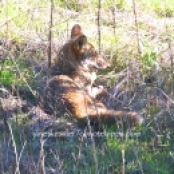-

-
Coyotes watch calmly most of the time — but they get upset by hyperactivity and dogs exploring on their own
-

-
running in the direction of a runner and his dog which is following at some distance
-

-
agitatedly looking around
-

-
suspicious of the running dog
-

-
trotting in dog’s direction
-

-
once the owner grabs his dog, the coyotes calm down
This time of year is when single coyotes who have not yet bonded with a mate are exploring beyond their natal territories, seeking out new areas to live either because of internal drives or because they have been kicked out by their birth families. At the same time, intact mated coyote pairs and their remaining offspring with established territorial claims are on the alert to keep these intruders out.
Recently I wrote about an intruder coyote exploring an area already claimed by a coyote family. The resident coyotes’ reaction was to drive the intruder out. They did this by behaving un-welcomingly and antagonistically: chasing and intimidating by their glares, punching with their snouts and even nipping: https://coyoteyipps.com/2014/12/29/new-face-on-the-block/
People with pet dogs need to be aware that this behavior towards other coyotes may also be directed at dogs. Coyotes may be on the lookout, especially during the next few months, for any canine that they think might want to move in and claim the territory: these include highly active dogs whose owners are not close to them. Their job is to dissuade these trespassers from moving in. All incidents can be prevented by keeping dogs leashed and moving on.
Today in one of our parks, two long-time resident coyotes kept their eyes on two sets of dogs who were extremely active, not leashed, and not terribly close to their owners. In one case, a man was running with two smallish dogs which lagged far behind him. The running and generally active behavior of the dogs is what alerted the coyotes that these two dogs might not just be passing through. The coyotes at first just watched them, but soon they became anxious and agitated as revealed by their behavior: getting up, standing erect and pacing back and forth as they watched. As the two dogs and owner ran on, both coyotes bounded up to follow. As soon as the runner and dogs headed out of the coyote area, the coyotes calmed down.
In the second case, there was one unleashed dog and owner who were fairly calm physically, but not necessarily psychologically calm. The coyotes and dog could read each other and, as instinct would have it, did not like each other: all canines seem to have an antipathy for one another: foxes, coyotes, wolves and dogs. The coyotes approached the dog within about 30 feet and there was minor but perceptible intimidation on the part of both the dog and the coyotes. I told the owner not to let his dog go after the coyotes, at which point he grabbed his dog by the collar and walked on. A human right next to a dog will dissuade coyotes from approaching.
To prevent any antagonistic incidents during this season — rare though they might be — it is very important for dog walkers to be aware of their surroundings and aware of what season it is for coyotes. When they see a coyote, they need to leash up immediately and walk on, away from the coyotes. This serves as a safety measure for both dogs and coyotes, and it is respectful of wildlife which is only following its instinctive behaviors. If a dog and coyote engage at a closer range, it can be pretty scary, because neither coyote nor dog will respond to an owner. The coyote may even message its antagonism with a nip to the dog’s haunches. If there are two coyotes, a dog may become baffled by the situation and not know what to do. The owner needs to move in and grab his dog quickly — but not if the coyote is too close to the dog and the dog is responding with bared teeth. Neither the coyote’s nor the dog’s intention is to bite the owner, but as the coyote attempts to message the dog and vice-versa, the owner could get scratched or bitten by dog or coyote. Please remember that these incidents are rare: the number of bites or scratches from coyotes to a human, usually because of this situation, amounts to about 17 a year for all of North America, whereas bites to humans from dogs sends 1000 humans to emergency rooms every single day. We all can prevent this eventuality by following simple guidelines: keep your dog leashed in a coyote area, if you see a coyote, move on and away from it, know how to shoo off a coyote if it is approaching.


































